Unit 6: Wound Management (Cram)
1/28
There's no tags or description
Looks like no tags are added yet.
Name | Mastery | Learn | Test | Matching | Spaced |
|---|
No study sessions yet.
29 Terms
What are the 4 physical phases of wound healing? Remember: It Doesn't Really Matter (probably won't be on the exam)
Inflammatory phase
Debridement phase
Repair phase
Maturation phase
True or false: Scar tissue is stronger and more supple than the original tissue
False. Scar tissue is never as strong or supple as the original tissue
What are the four categories of wound cleanliness?
Clean
Clean–contaminated
Contaminated
Dirty
Which category of wound cleanliness involves the gross spillage of organ contents?
Contaminated
Which category of wound cleanliness involves minor breaks in aseptic technique?
Clean–contaminated
Which category of wound cleanliness involves contaminated traumatic wounds more than 4 hours old?
Dirty
What are the three classifications of wound healing?
First intention
Second intention
Third intention
Which classification of wound healing involves open healing with granulation tissue?
Second intention
Which classification of wound healing involves the restoration of wound continuity without granulation?
First intention
Which classification of wound healing involves the wound being too contaminated to close?
Third intention
When flushing a wound, should you use alcohol or hydrogen peroxide?
No, they can damage tissue
What are the two ways to fix the bone fragments in place, so that they are stable and will not move?
Splinting the limb (splints, casts, etc.)
Splinting the bone (bone plates, pins, etc.)
How many layers should all wound dressings have?
3 layers
What are the three wound dressing layers?
Primary (aka contact layer)
Secondary (aka padding layer)
Tertiary (aka protective layer)
What direction do you wrap horse legs? Right and left legs respectively
Right leg: Clockwise
Left leg: Counterclockwise
What is used to keep the bandage from slipping?
Stirrups
What is the most common reason for a tail bandage in a dog?
Happy tail
How often should a bandage be checked for things like chafing, heat, pain, swelling, etc?
Daily
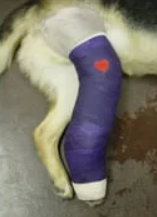
What kind of bandage is this?
Robert Jones bandage
Is the Robert Jones bandage long term or short term?
Short term
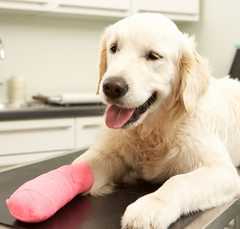
What kind of bandage is this?
Paw bandage
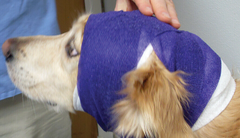
What kind of bandage is this?
Ear bandage

What kind of bandage is this?
Chest bandage
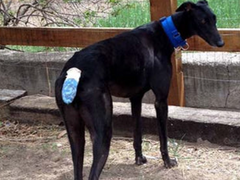
What kind of bandage is this?
Tail bandage
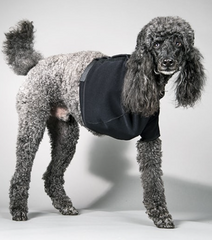
What kind of bandage is this?
Velpeau sling
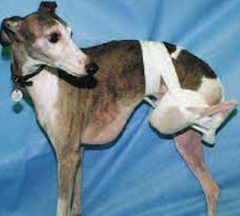
What kind of bandage is this?
Ehmer sling
What kind of injury is the Ehmer sling used on?
Hip subluxation
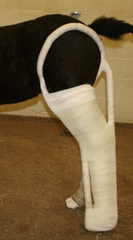
What kind of splint is this?
Schroeder-Thomas splint
Should you apply a cast to a open/compound fracture?
No